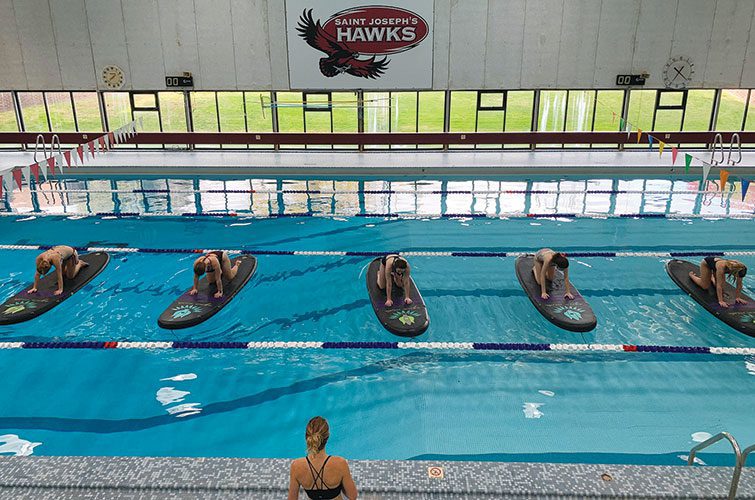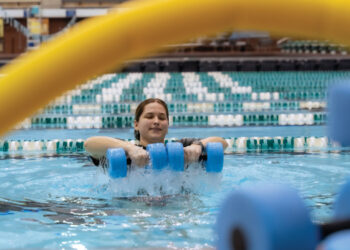Aquatics programming took quite a hit during the pandemic. But luckily, nearing the end of 2021, many campus recreation departments are finding their patrons are eager to dive back in. Here, two campus rec professionals share how they are looking ahead and planning to revamp aquatics programming in 2022.
The Bounce Back
Joan Mccallum, the assistant aquatics manager for Athletics and Recreation at the University of California, Santa Cruz (UC Santa Cruz), said her experience so far is patrons appear to be eager to swim at their outdoor facility. Mccallum explained they minimize the use of shared equipment. Plus, unless a patron is swimming at a busy time, they probably have half a lane to themselves.
“I do think in the post-COVID world, people are interested in resuming activity but are much more aware of space concerns,” she said. “Swimming has always provided an excellent all-body workout and will continue to do so. Particularly if people have been more sedentary during the pandemic, it’s a great way to start moving the body again.”
Alexandra Kissinger, the assistant athletics director for Campus Recreation at Saint Joseph’s University, agreed with Mccallum. She stated the limited offerings of swimming and aquatics classes in the past year will likely cause these forms of recreation to gain popularity.
“From our perspective, we’ve seen an increase of students using our pool over the past year and hope they continue this use,” said Kissinger.
Marketing and Engagement
While current patrons appear to be ready to return to aquatics offerings, one of the biggest aspects is making sure to market and reach the freshman classes. Kissinger shared Campus Recreation plans to work with departments across campus to get the word out about their pool and programs.
“This means reaching out to our resident assistants during the first few weeks of the semester to target the freshman class and get them interested in not only the pool but the recreation center,” she said. “We also try to stay up-to-date on our social media pages and hope it reaches new and interested students, parents and community members.”
Kissinger said her team will use Facebook, Twitter and Instagram to target students, staff and outside sources. They also use Canva to create graphics and Hootsuite to schedule posts. Out of the social platforms her team uses, Kissinger said they see the most interactions and engagements on Instagram.
EXTRA CREDIT: Hit hard by the pandemic, many schools have creative ways to still offer the programs their communities were asking for.
“Our most popular posts include pictures of our students participating in our events or programs,” she said. “In some instances, we hold Instagram Story polls where we’ll surprise a random user with a giveaway. It creates interest and keeps students engaged with what we have to offer. We’ll also repost stories that include students participating in our club sports, intramurals and other recreation activities.”
Overall, Kissinger said being active on social media is important as it keeps students aware of what’s available. It also gives them a chance to informally reach out and gather information. They can also ask questions about what a department and facility have to offer.
Combating the Lifeguard Shortage
During the summer, due to the national lifeguard shortage many rec centers struggled with staffing. This shortage raised concerns for leadership staff planning for the 2022 academic year.
Moving forward, Mccallum said with relaxing social distancing guidelines and more vaccinations, there will be more training opportunities. “During COVID-19 there weren’t opportunities to certify guards or for current guards to keep their certifications up to date,” she said. “Many guards allowed their certifications to lapse or found employment elsewhere and are not interested in returning to guarding.”
Mccallum shared her team planned to offer a recertification class at the start of the 2021-2022 academic year in order to get more qualified candidates. The class made sure all successful candidates had the required certifications to be interviewed.
Plans to combat the lifeguard shortage at Saint Joseph’s University are similar. “We try to retain our guards by working with them and their class schedules while also providing reasonable open swim hours to our students, staff and members,” said Kissinger. “In some instances, we will pay for recertification classes and professional development sessions.”
Aquatics Programming for 2022
As COVID-19 infection and vaccination rates change and adjust over the next year, it can be difficult to fully plan ahead. Mccallum said at UC Santa Cruz, they will be exploring ways to provide access to more groups. They will look particularly at those who have been underserved in the past.
“One of the positives that came from COVID-19 is ‘how we’ve done things in the past’ is no longer an operating norm,” she said. “The pandemic forced all of us to reevaluate how we do things and to reimagine the future. I also think there is more cooperation regarding sharing of ideas. I would suggest reaching out to similarly situated facilities for partnership.”

At Saint Joseph’s University, Kissinger shared during the past year they tried a few new programs such as paddle board yoga and HIIT classes. Her team hopes to bring that aquatics programming back in 2022. They will incorporate water aerobics classes, swim lessons and scuba lessons.
“I would advise other departments to stay up-to-date on the newest trends, but overall, listen to your students,” she said. “They are the main users of your facilities, so make sure their suggestions and feedback are heard. That could mean anything from increasing open swim hours to implementing a new program that suits their needs.”










